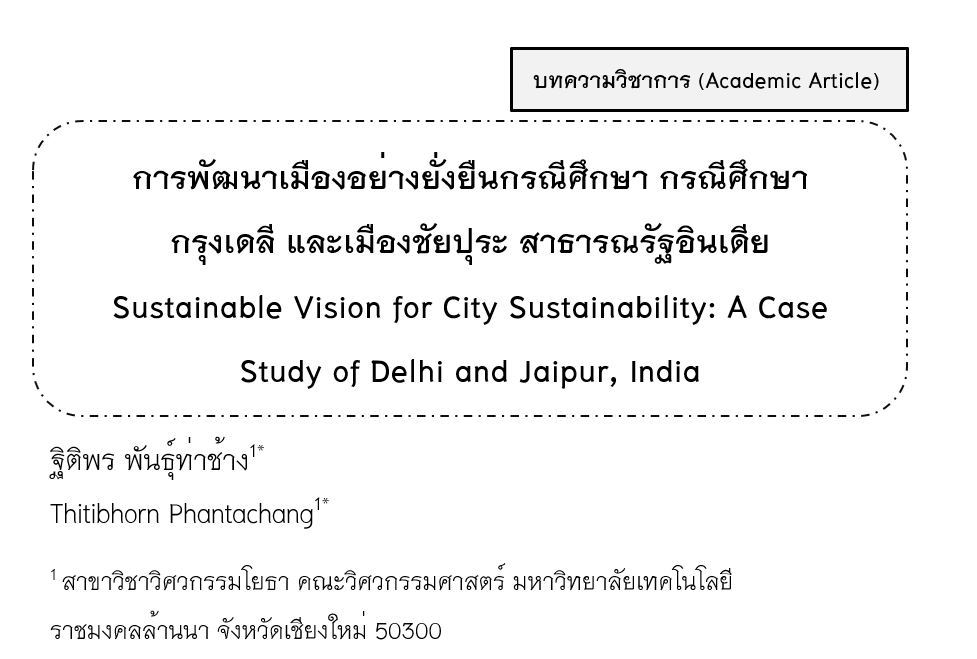Sustainable Vision for City Sustainability: A Case Study of Delhi and Jaipur, India
Keywords:
India, Sustainable Development, Environment, Smart City, InfrastructuresAbstract
The 17 Sustainable Development Goals (SDGs) were committed by the United Nations to adopt by the member states of the United Nations to create a sustainable development goals for all human beings. All nations have already committed to achieving the goals of the SDGs by 2030. India has played an important role in shaping the sustainable development goals with the mission of sustainable development of the country. As of the largest country by area and the second largest population in the world. Additionally, to achieve sustainable development it requires systematic solutions, technology development, urban planning, improvement of infrastructures and service, investment promotion, and public consciousness. To overcome these challenges, the five missions were set up to facilitate the implementation of these goals such as Smart Cities Mission, Atal Mission for Rejuvenation and Urban Transformation (AMRUT), Mission Heritage City Development and Augmentation Yojana (HRIDAY Mission), Swachh Bharat Mission and Urban Transport. The adaptive governance framework and the example of implementation projects in India suggest perhaps it may be adaptable for developing countries to achieve the SDGs goals by 2030.
References
นพรัตน์ ทองอุไร. (2557). การก้าวขึ้นสู่ฐานะมหาอำนาจใหม่อินเดีย. วารสารสังคมศาสตร์ มหาวิทยาลัยนเรศวร, 10(1), 5-39.
สมพร แสงชัย. (2561). วิวัฒนาการแนวคิดของการพัฒนาที่ยั่งยืน. วารสารการจัดการสิ่งแวดล้อม, 14(2): 6-111, จาก https://so02.tci-thaijo.org/index.php/JEM/article/view/150326/117148.
สยาม อรุณศรีมรกต และ ยงยุทธ วัชรดุลย์ (2559). เป้าหมายการพัฒนาที่ยั่งยืน 17 ประการของสหประชาชาติเพื่อโลกอนาคต. วารสารวิจัยสหวิทยาการไทย,11(3), 1-7, จาก https://en.mahidol.ac.th/thai/publication/2016/2559-17objectives.pdf.
Agarchand, N. and Laishram, B. (2017), Sustainable infrastructure development challenges through PPP procurement process: Indian perspective. International Journal of Managing Projects in Business, 10(3), 642-662.
Almuktar, Suhad, Suhail Najem Abed and Miklas Scholz. (2018). Wetlands for wastewater treatment and subsequent recycling of treated effluent: a review. Environmental Science and Pollution Research.
Assembly, G. (2015). Sustainable Development Goals. SDGs, Transforming our world: the, 2030.
Bhattacharya, S., Patro, S. A., and Rathi, S. (2016). Creating Inclusive Cities: A Review of Indicators for Measuring Sustainability for Urban Infrastructure in India. Environment and Urbanization ASIA, 7(2), 214–233.
Bhattacharya, Shrimoyee, Sujaya Rathi, Sonali Anusree Patro, and Niepukhrie Tepa. (2015). Reconceptualising smart cities: a reference framework for India. CSTEP-Report-2015-03.
Byskov, Jens, Stephen Maluka, Bruno Marchal, Elizabeth H. Shayo, Astrid Blystad, Salome Bukachi, Joseph M. Zulu, Charles Michelo, Anna-Karin Hurtig, and Paul Bloch. (2019). A systems perspective on the importance of global health strategy developments for accomplishing today’s Sustainable Development Goals. Health policy and planning, 34, 635-645.
Central Intelligence Agency (CIA). (2019). The world fact book: Country Comparison: Area. Retrieved December 15, 2019, Form https://www.cia.gov/library/publications/the-world-factbook/rankorder/2147rank.html.
Datta, Ayona. (2015). New urban utopias of postcolonial India: ‘Entrepreneurial urbanization’in Dholera smart city, Gujarat. Dialogues in Human Geography, 5(1), 3-22.
Gupta, J., and Vegelin, C. (2016). Sustainable development goals and inclusive development. International environmental agreements: Politics, law and economics, 16(3), 433-448.
JNNURM Directorate, Ministry of Urban Development and National Institute of Urban Affairs (NIUA). (2011). India’s Urban Demographic Transition, The 2011 Census Results (Provisional).
Karn, Sunil Kumar, and Hideki Harada. (2001). Surface water pollution in three urban territories of Nepal, India, and Bangladesh. Environmental Management, 28, 483-496.
Kumar, S., Kumar, N., and Vivekadhish, S. (2016). Millennium development goals (MDGS) to sustainable development goals (SDGS): Addressing unfinished agenda and strengthening sustainable development and partnership. Indian journal of community medicine: official publication of Indian Association of Preventive & Social Medicine, 41(1), 1.
Le Blanc, D. (2015). Towards integration at last? The sustainable development goals as a network of targets. Sustainable Development, 23(3), 176-187.
McKinsey Global Institute Report. (2010). India's urban rising. Retrieved December 15, 2019, Form http:// https://www.mckinsey.com/mgi/overview/in-the-news/urban-rising-in-india.
Ministry of Drinking Water and Sanitation, Government of India. (2017). Vision The aim of Swachh Bharat Mission (Gramin). Retrieved September 1, 2019, Form https://swachhbharatmission.gov.in/SBMCMS/about-us.htm.
Ministry of Housing and Urban Affairs Government of India. (2016). ATAL Mission for Rejuvenation and Urban Transformation. Retrieved September 1, 2019, Form http://amrut.gov.in/content/innerpage/the-mission.php.
Ministry of Housing and Urban Affairs Government of India. (2016). Heritage City Development and Augmentation Yojana (HRIDAY). Retrieved September 1, 2019, Form https://www.hridayindia.in/about-the-scheme/.
Ministry of Housing and Urban Affairs Government of India. (2016). Smart Cities Missions. Retrieved September 1, 2019, Form http://smartcities.gov.in/content/innerpage/what-is-smart-city.php#.
Ministry of Urban Development, Government of India. (2006). National Urban Transport Policy. India: New Delhi. Retrieved September 1, 2019, Form https://smartnet.niua.org/content/a8324d56-2338-4538-b54a-3a276f9f8bd2.
Office of the Registrar General & Census Commissioner, India Ministry of Home Affairs, Government of India. (2011). Area and Population of INDIA. Retrieved December 15, 2019, Form http://censusindia.gov.in/Census_And_You/area_and_population.aspx.
Registrar General and Census Commissioner, India. (2011). Census of India 2011 Report on post Enumeration Survey. Retrieved December 15, 2019, Form http://www.censusindia.gov.in/2011Census/pes/Pesreport.pdf.
Sadoway, David, and Satyarupa Shekhar. 2014. (Re) Prioritizing Citizens in Smart Cities Governance: Examples of Smart Citizenship from Urban India. The Journal of Community Informatics, 10(3), Form http://128.163.188.57/index.php/ciej/article/view/1179.
Thaker, Jagadish and Anthony Leiserowitz. (2014). Shifting discourses of climate change in India." Climatic Change, 123(2), 107-119.
The World Bank. (2018). Data of India. Retrieved September 1, 2019, Form https://data.worldbank.org/country/india.
United Nations. (2016). The Content of This Publication Has Not Been Approved by the United Nations and Does Not Reflect the Views of the United Nations or Its Officials or Member States. Retrieved December 1, 2019, Form https://www.un.org/sustai nabledevelopment/.

Downloads
Published
How to Cite
Issue
Section
License
Copyright (c) 2021 Phayao University

This work is licensed under a Creative Commons Attribution-NonCommercial-NoDerivatives 4.0 International License.
ผู้นิพนธ์ต้องรับผิดชอบข้อความในบทนิพนธ์ของตน มหาวิทยาลัยพะเยาไม่จำเป็นต้องเห็นด้วยกับบทความที่ตีพิมพ์เสมอไป ผู้สนใจสามารถคัดลอก และนำไปใช้ได้ แต่จะต้องขออนุมัติเจ้าของ และได้รับการอนุมัติเป็นลายลักษณ์อักษรก่อน พร้อมกับมีการอ้างอิงและกล่าวคำขอบคุณให้ถูกต้องด้วย
The authors are themselves responsible for their contents. Signed articles may not always reflect the opinion of University of Phayao. The articles can be reproduced and reprinted, provided that permission is given by the authors and acknowledgement must be given.







